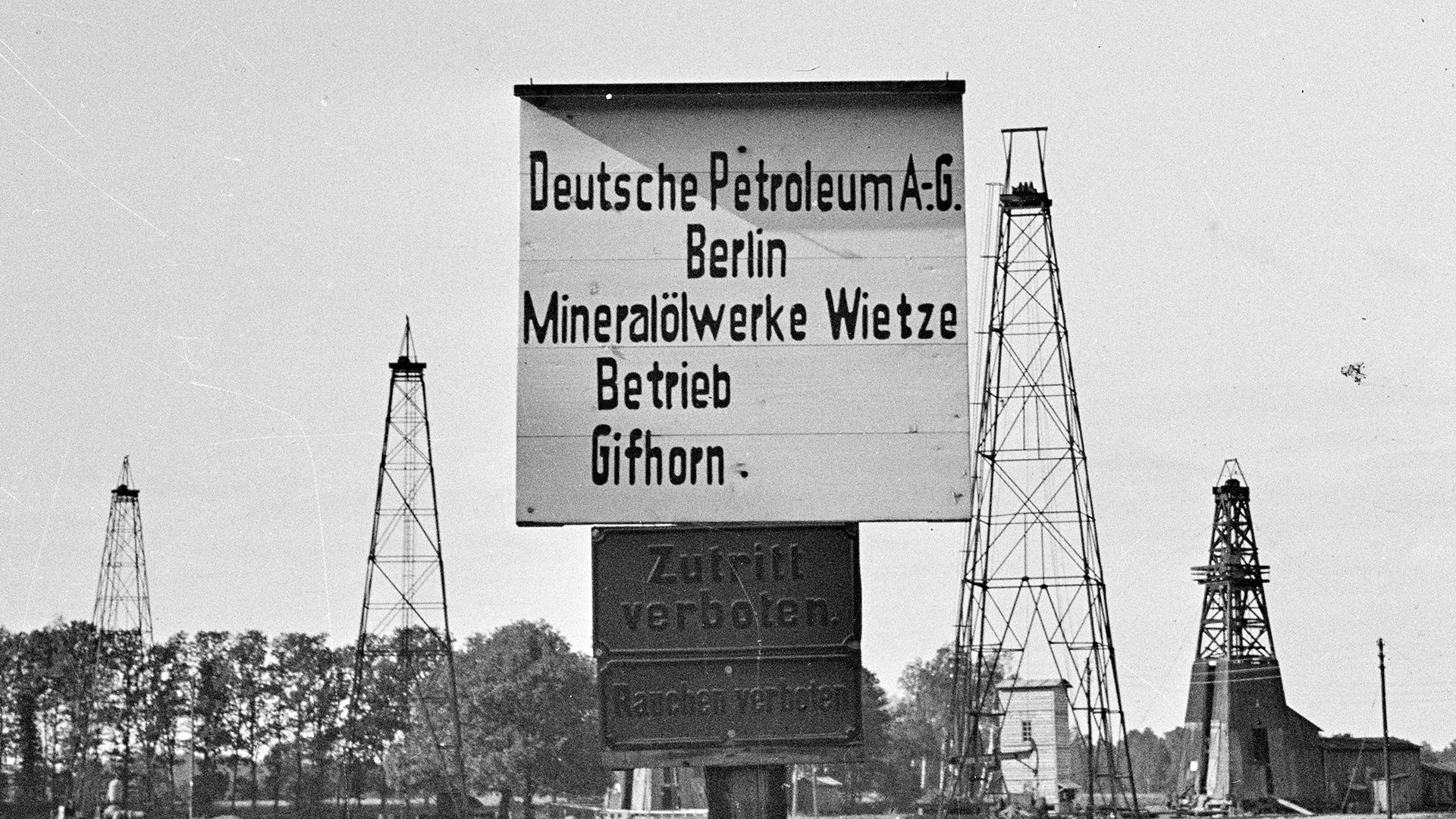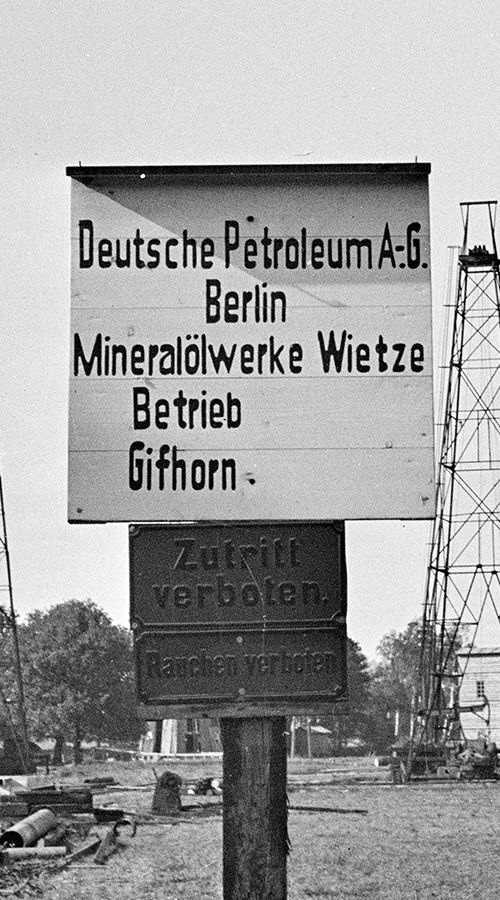Beneficiaries beyond 1945 Marvin Brendel


Oil exploration in the Gifhorn area in 1935 was co-financed by the Reich drilling programme.
Beyond 1945: DEA and Wintershall as beneficiaries of the Reich drilling programme
Marvin Brendel
(agency All About Assets, for Wintershall Dea)
The go-ahead for the Reich Drilling Programme was given on 10 January 1934 at a meeting in the Reich Ministry of Economics with representatives of the major oil companies, including mining assessor Günther Schlicht for Deutsche Erdöl Aktiengesellschaft (DEA) and director Curt Beil from Wintershall AG. On this occasion the Reich government announced that the state would in future provide financial support to German oil companies for the “planned development of new German oil fields”.
The state assumed half of the pure drilling costs for selected “Reich wells”. Only if a well proved to be economically viable – in other words, if production there was economically worthwhile – was the state subsidy converted into a loan that the companies had to repay with interest from the earnings from production. The Reich Drilling Programme was flanked in 1934 by several new laws. The main innovations included the cancellation of land ownership rights to crude oil, natural gas and bitumen and the introduction of state retention of title to such raw materials. Here, the state then awarded concessions for larger areas.
Increasing demand for oil
The Reich Drilling Programme was already based on the National Socialists’ employment policy at the start of the 1930s, when they wanted to boost German oil production by increasing drilling activity. The idea corresponded not only with the fundamental pursuit of autarky and securing raw materials in the event of war, but also with the promotion of motorised transport and the expansion of the road network likewise being pursued – measures that went hand in hand with an increased demand for fuels and bituminous building materials for road construction. This resulted in higher imports of crude oil and oil products, which in turn meant increased foreign currency expenditure. Although German oil production had risen from 35,026 to 103,306 tonnes in the 1920s, this was mainly due to the expansion of production in the two largest oil fields, Nienhagen and Wietze, which had already been known for some time. In addition, German production remained low compared to consumption. The gap was filled by oil imports, which amounted to a good 2.7 million tonnes in 1929 alone.
The number of Reich wells from 1934 to May 1945 varies between 643 and 776 depending on the source – depending in particular on whether only the “old Reich” or also the territories annexed or conquered later were included in the statistics. The figures for wells discovered and the resulting new oil and gas deposits likewise fluctuate. In addition to the geographical demarcation, the decisive question here was when a well is actually classified as successful – already when smaller quantities of oil or gas were released or only when it was “economically viable”.
Both DEA and Wintershall use the Reich Drilling Programme extensively
In contrast, the question of the biggest profiteers of the Reich Drilling Programme is clearer: by the end of March 1944 alone, the four companies Gewerkschaft Elwerath (in which Wintershall had a one-third share), DEA, Preußag and Wintershall had drilled the most metreage by far and received the most state subsidies. At that time, they together accounted for over 70 per cent of the drilling output of around 635,800 metres recorded up to that point and a good 68 per cent of the Reich subsidies and loans totalling around 46.5 million Reichsmarks.
According to a new analysis of various sources, Wintershall and DEA are responsible for at least 286 Reich wells, either directly or via subsidiaries. They were involved in other wells via consortia, but these links are difficult to trace from the statistics alone. At least 27 of the successful wells can be directly attributed to Wintershall and/or DEA. In the “old Reich” alone – and only this area is considered here for this essay – they led to the discovery of nine oil and two smaller natural gas deposits (the latter of which were located in the territory of the later GDR). DEA and Wintershall benefited from two other new oil fields through consortium partnerships.
New sites produce oil for decades
Among the discoveries were a number of very small deposits, such as Tegernsee or Hope-Adolphsglück, which only yielded very small production volumes. But there were also much larger fields from which both companies were able to produce oil for many years if not decades after the end of the Second World War. One example particularly worth mentioning here is Heide oil field in Schleswig-Holstein, which was drilled in 1935 and where DEA only switched off the production pumps in 1992. The Gifhorn oil field, also discovered by DEA in 1935, proved to be less productive, but was nevertheless still in production until 1956.
Wintershall’s greatest strike co-financed via the Reich Drilling Programme was undoubtedly the discovery of the Emlichheim oil field on the German-Dutch border in 1943. It is still an important site for Wintershall Dea’s domestic production today, where more than eleven million tonnes of crude oil have been extracted from the earth to date. Wintershall also benefited for a longer period from the Eicklingen and Meckelfeld/Stelle deposits discovered in 1937 and 1938, which were in production until 1993 via additionally developed sub-fields. Mention should also be made here of the Aldorf oil field, which laid the foundation for the Barnstorf site, which still belongs to Wintershall Dea today. Although it was only discovered by Wintershall in 1952, the first signs of crude oil potential had already been found here in 1944/45 during Reich drilling.
With the collapse of the so-called “Third Reich”, the Reich Drilling Programme also came to an end. During the time of National Socialism the programme laid the foundation that was to have a major influence on the development of Wintershall and DEA – even long after the end of the war in 1945. Wintershall, which had only entered the oil production business in 1931, undoubtedly benefited from the Reich Drilling Programme in its rapid rise to become one of the leading German oil producers. At DEA, which had turned more strongly to coal mining after the First World War, the discoveries made through the Reich Drilling Programme led to a return to a more oil-focussed corporate strategy.
After 1945, the proceeds from the ongoing oil production in Emlichheim, Meckelfeld and Heide also helped both companies to finance the renewed upturn and their expansion abroad, which began in 1954. In this respect, the investigation of the Reich Drilling Programme and its effects on Wintershall and DEA provide a deeper insight in the reappraisal of the National Socialist past of the merged Wintershall Dea.


About the author
Marvin Brendel has been working as a freelance economic and corporate historian since 2007 and has conducted research into the history of German cooperatives and the German retail trade, among other things. Since 2017, he has been working as an external corporate historian for Wintershall Dea through the agency All About Assets (Berlin). He has researched various facets of the company's history and presented the results in the form of articles, brochures, exhibitions and lectures. Following the publication of "Expansion at any cost" by Manfred Grieger, Rainer Karlsch and Ingo Köhler, Marvin Brendel conducted research on the Reich drilling programme, among other things, to deepen the knowledge of Wintershall AG's history in the Nazi period.